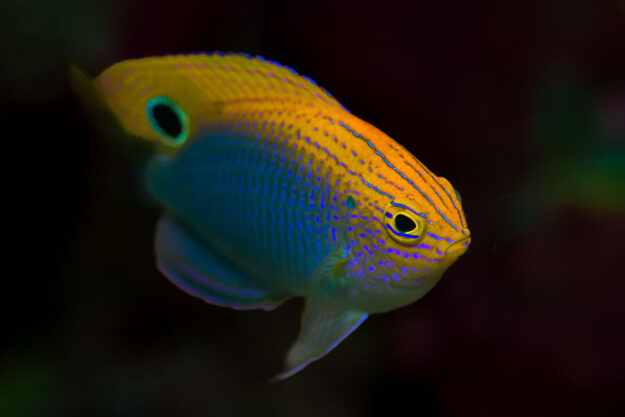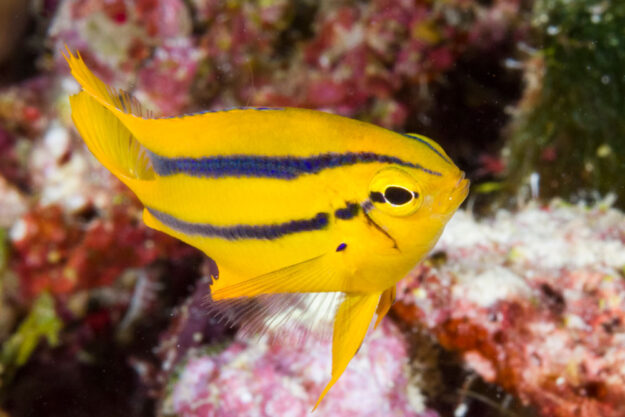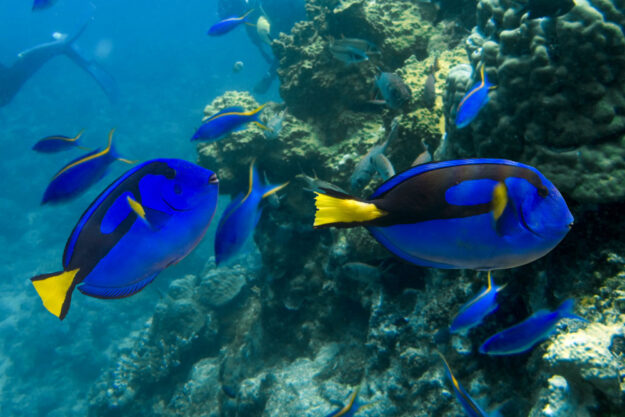Wakatobi’s Vegetarians
Wakatobi’s underwater landscape may seem like a placid environment, but in reality, it’s a fish-eat-fish world where most everything that swims is both a hunter and the hunted. Mixed in with all these ruthless carnivores and omnivores are a lesser number of creatures that don’t prey on their neighbors, and instead sate their appetites with aquatic greenery of one type or another. These marine vegetarians fill a relatively small but vitally important niche in the marine environment, as their grazing habits keep algae from overgrowing reefs and help keep seagrass beds tidy and vibrant. These plant eaters are present on every dive site surrounding Wakatobi Resort, so let’s meet some of the region’s more interesting undersea vegetarians.
Get off My Lawn
Some members of the damselfish family don’t just graze the reefs of Wakatobi, they farm them. These aquatic agrarians will stake out a patch of coral and set to work creating a personal algae patch. They do this by repeatedly biting live coral tissue to create skeletal lesions that are then colonized by filamentous algae.

The damselfish is highly territorial, and can become aggressive when an interloper wanders into its garden. Photo by Marcus Lindenlaub, outdoorimages.eu
Much like a suburbanite defending his prized patch of turf, the damselfish is highly territorial, and can become quite aggressive when an interloper wanders into the algae patch. Once a damselfish has established a garden, it lives a solitary life close to home, spending most of its days within a territory of a half square meter or less. On occasion, the damselfish will make forays out into the wider world.

Juvenile yellowtail damselfish are more colorful than their adult counterpart, but just as assertive about keeping you off their lawn. Photo by Walt Stearns
Quick trips within a few meters of home are usually made to grab a fast meal away from the garden, while longer absences happen only when it’s time to mate, or to find a more promising grow site. The damselfish’s polyp-nipping habits do actually cause some harm to the corals. But when the ecosystem is in balance, there are plenty of predators such as lizardfish, small jacks, sweetlips and frogfish that prey on damselfish and keep populations in check. Just one more reason why it’s important to protect the reefs and maintain the marine no-take zones that ensure the natural order.
Beware This Hare
It’s not hard to see how rabbitfish got their name. The combination of an elongated snout, large eyes and small mouths filled with dainty teeth evokes a certain resemblance to the long-eared mammals of field and forest. Like their terrestrial namesake, rabbitfish emerge from sheltering nooks when the sun rises and spend their days placidly grazing on the assorted algae that thrive in shallow bays and on coral formations. There are 29 known species of rabbitfish found in the waters around Wakatobi, and some can grow up to lengths of a half meter. Most favor olive or brown coloration, with yellow, black and white markings on the body and tail.

There are 29 known species of rabbitfish found in the waters around Wakatobi, and some can grow up to lengths of a half meter. Photo by Vladimir Wrangel
Some species have black stripes that stretch diagonally from mouth to the top of the head and cover the eyes. These are known as the foxfaced rabbitfish. Youngsters often hang out in schools, but as they mature, rabbitfish pair up, and are thought to mate for life. Though seemingly vulnerable to predators as they graze, rabbitfish do have some survival tricks. The first line of defense is an ability to rapidly change color, transforming their bright markings and stripes into a dull, splotch pattern that resembles military camouflage. Rabbitfish take on this pattern to blend into their surroundings when threatened, or when asleep at night. If hiding doesn’t work, the real deterrent is a line of venomous, spine-like fins that can be raised to discourage attacks. Rabbitfish are not aggressive by nature, but they will give an assailant a poisonous poke if need be.
A Celebrity Sighting
You’ll know one when you see it. The yellow tail and yellow-tipped pectoral fins; the small, pouty mouth; the two-toned blue and indigo body. You’ve found Dory. Paracanthurus hepatus to be more precise, though this member of the surgeonfish family has enough common names to give anyone memory loss.

As they mature and adopt their signature color patterns, the palette surgeonfish (Paracanthurus hepatus), aka regal blue tang, acquire a taste for algae. Photo by Walt Stearns
Stick with regal blue tang to avoid any confusion with the all-blue Caribbean cousin, which lacks the extras coloration required to earn the royal reference. These fish are social, and can often be found in pairs or groups that may include other species of surgeonfish. Younger fish are even more likely to move in schools as they scour the water column for plankton.

Regal blue tang are social, and can often be found in pairs or groups that may include other species of surgeonfish. Photo by Ian Scott
Just don’t expect to see a baby Dory, because the juveniles are actually bright yellow with blue spots. As they mature and adopt their signature color patterns, regal blue tangs also acquire a taste for algae, and become an important member of the reef cleaning crew. Like other surgeonfish, they sport poison-tipped and razor-sharp spines that give would-be predators reason to pause. If that doesn’t work, the regal may play dead by lying on its side and remaining motionless until the threat passes. If you are lucky, you may witness a pair of males engaged in an underwater sword fight, using their caudal spines to settle territorial disputes.
Trimming the Grass
Green sea turtles are a familiar sight on the reefs of Wakatobi, and you’ll often encounter youngsters in the grass beds close to the beach. Juveniles spend their early months nibbling on sponges, crabs and worms, but as they grow, they switch to algae and seagrass.

Snorkel over the seagrass meadow on Wakatobi’s House Reef and you’re likely to find a green turtle noshing on the vegetation. Photo by Walt Stearns
Venture into the seagrass meadow and you may find a green turtle noshing on the vegetation. And that’s a good thing, because their grazing is a benefit rather than a threat to the plants.
Studies show that when turtles graze, they create a marked increase in the productivity and nutrient content of the grass bed.
Turtles don’t just grab a mouthful of grass, they focus on the younger and more nutritious mid sections of the blades, while older and less nutritious top portions are bit off and left to float free and drift away. This close cropping encourages new growth. Studies show that when turtles graze, they create a marked increase in the productivity and nutrient content of the grass bed. Without turtles, grass beds would suffer. Plants would overgrow and fill the sea floor with decomposing material that block nutrients from reaching roots, and promote the growth of slime molds.


